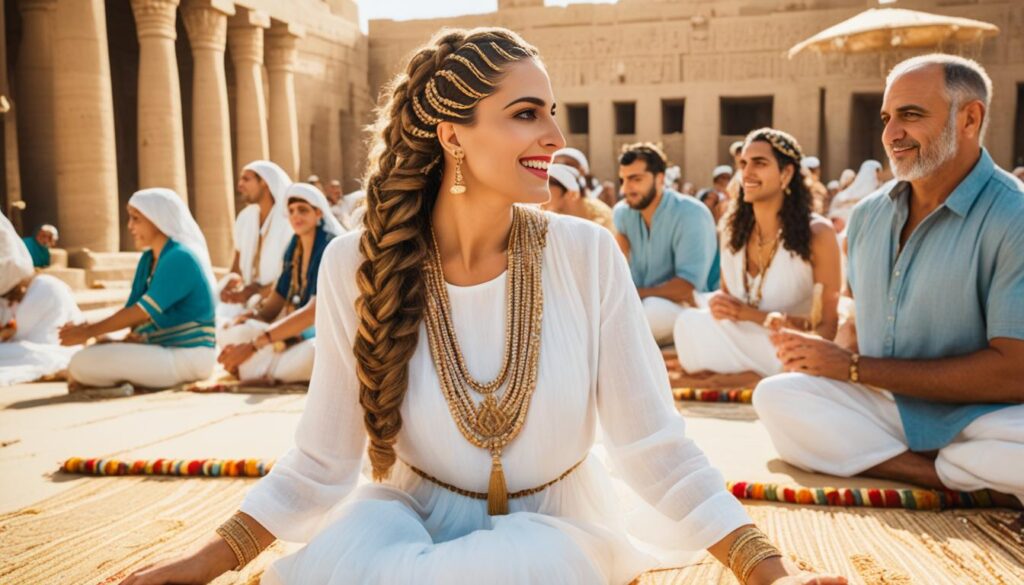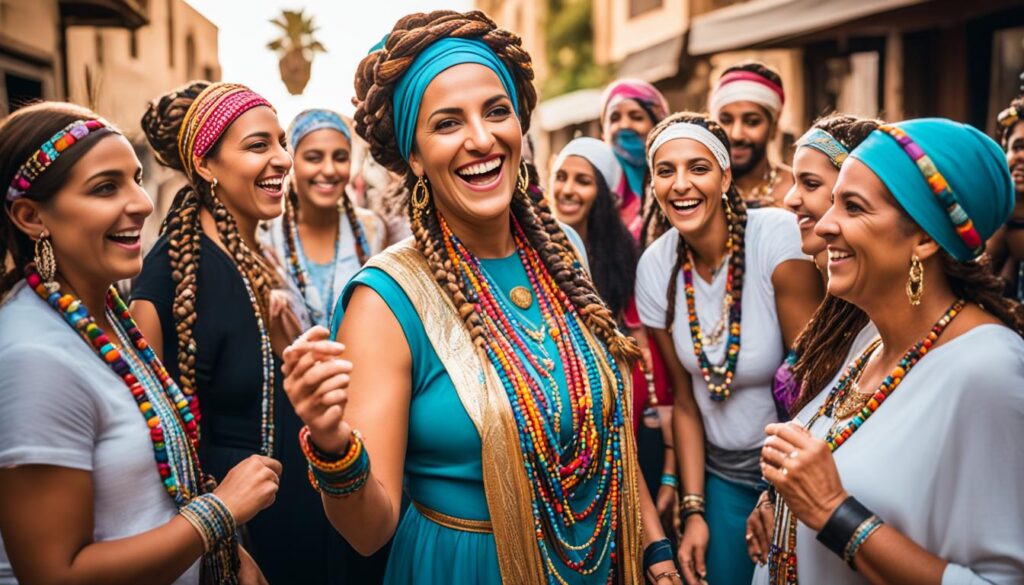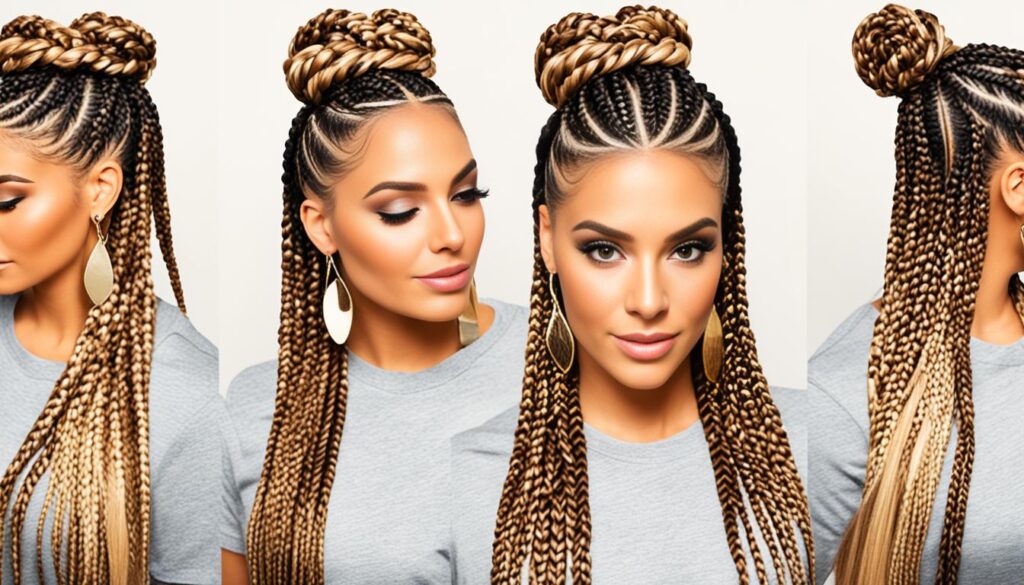
When we think of ancient Egyptian imagery, we often picture individuals with elaborate headdresses and intricate hairstyles. But did the Egyptians actually braid their hair? The answer may surprise you. In fact, hair braiding was a common practice in ancient Egypt and held great cultural significance. From simple practical braids to ornate styles adorned with beads and jewels, braided hair was an integral part of ancient Egyptian beauty and fashion.
- Ancient Egyptians did indeed braid their hair, with both men and women embracing various braiding techniques.
- Braided hairstyles in ancient Egypt served not only as a fashion statement but also as a way to signify social status and ward off evil spirits.
- Elaborate braided hairstyles adorned with beads, jewels, and extensions were often worn by the wealthy, while simpler braids were common among the general population.
- The cultural significance of braided hair in ancient Egypt extended beyond mere aesthetics, providing insights into social hierarchy, power dynamics, and personal expression.
- Ancient Egyptian braided hairstyles influenced and inspired hair trends across different cultures and time periods.
The History of Braids
Braiding hair has a rich history that spans across different cultures and time periods. From African cornrows to Greek goddess braids, braided hairstyles have left an indelible mark on our collective beauty traditions. Let’s explore the fascinating journey of braids through time and cultures.
Ancient African Cornrows
One of the earliest recorded instances of braiding can be traced back to ancient Africa, dating as far back as 3500 B.C. African cornrows were not only a practical way to manage hair but also a form of cultural expression. These intricate braiding styles varied based on a person’s kinship, age, ethnicity, and religion, serving as a visual representation of their identity.
Ancient Egyptian Braids
Ancient Egyptians were renowned for their elaborate hairstyles, including braids. Egyptians adorned their braids with intricate weaves, beads, and extensions to create stunning and intricate looks. Braided hairstyles in ancient Egypt symbolized beauty and social status and were often associated with wealth and luxury.
Greek Goddess Braids
In ancient Greece, braids were not only a symbol of beauty but also a reflection of social status. Greek goddess braids were popular among women, and they used braids to indicate their social standing and enhance their beauty. Braided hairstyles were intricately woven and often adorned with decorative elements like ribbons and jewelry.
Native American Braids
Native American tribes had their own unique braiding styles that held cultural and spiritual significance. Braids were an integral part of Native American culture, and they often carried symbolic meanings. Different tribes had their distinct braiding techniques, with braids representing traditions, tribe affiliations, and personal spirituality.
Medieval European Braids
In medieval Europe, braided hairstyles were popular but often dictated by societal norms of modesty. Women, particularly those from the nobility, were expected to keep their hair hidden under headdresses and veils. Braids were often intricately woven into crowns, fishtail braids, and other elegant styles, highlighting an ideal of femininity and virtue.
Mongolian Braids
Mongolian braids emerged in the 13th century and were often incorporated into elaborate headpieces. These braided hairstyles were characterized by their intricate patterns and architectural forms, with braids being an integral part of Mongolian traditional costumes and headwear.
Modern Cornrows
Fast forward to modern times, and we see a resurgence in the popularity of cornrows, particularly during the Black is Beautiful movement of the 1960s and 1970s. Cornrows, characterized by tight, flat braids close to the scalp, became a powerful symbol of Black pride and cultural identity. They continue to be embraced today as a statement of style and heritage.
Significance of Braids in Ancient Egypt
In ancient Egypt, braided hairstyles held great cultural and social significance. Braids were not only a practical way to keep the hair out of the face in the desert heat but also served as a visible symbol of a person’s class, status, and nature. Whether worn by the wealthy elite or the common people, braids in ancient Egypt were an essential part of the overall style and appearance.
The ancient Egyptians were known for their intricate braiding techniques, often adorning their braids with decorative elements such as beads, jewels, and extensions. These elaborate hairstyles showcased the wealth and social status of individuals, as well as their ability to accessorize and adorn themselves. A truly stunning example of Egypt’s intricate braiding style can be seen in the braided headdresses worn by Cleopatra, the famous queen of Egypt, which still inspire hairstyles today.
Beyond the aesthetics, braided hairstyles in ancient Egypt were believed to have spiritual and supernatural significance. Egyptians believed that braids had the power to ward off evil spirits and bring good luck. The act of braiding the hair was considered a form of protection and an expression of connection to the divine.
Furthermore, braided hairstyles played a role in society’s perception of an individual’s character. Braids were believed to reveal aspects of a person’s nature, such as their strength, wisdom, and devotion. The style, intricacy, and adornments of the braids could provide insights into a person’s personality, social standing, and even their occupation.
To illustrate the social and cultural significance of braids in ancient Egypt, here is an example of the different styles and meanings associated with braided hairstyles:
| Braided Style | Meaning |
|---|---|
| Elaborate, intricately woven braids adorned with beads, jewels, and extensions | Symbolized wealth, social status, and beauty |
| Simpler, more practical braids | Indicated common status and practicality |
| Braids with specific patterns or arrangements | Revealed a person’s nature, such as strength or wisdom |
Through their braided hairstyles, ancient Egyptians communicated their social standing, personal identity, and connection to the divine. The significance and beauty of these hairstyles continue to inspire and captivate people around the world today.

Evolution of Hair Braiding across Cultures
Hair braiding has been a universal styling technique that can be found in various cultures throughout history. It has evolved and adapted to reflect the beauty ideals, cultural traditions, and societal norms of different regions and time periods. Let’s explore the fascinating evolution of hair braiding in ancient Greece, indigenous American tribes, and medieval Europe.
Hair Braiding in Ancient Greece
In ancient Greece, braided hairstyles were not only a symbol of beauty but also a reflection of social status and occupation. Greeks believed that well-styled hair was a sign of good grooming and class, with braids being an essential component of a polished appearance. Different braiding techniques were utilized to create intricate patterns and designs. Braided hairstyles were commonly adorned with accessories like ribbons, beads, and even gold leaves to enhance their aesthetic appeal.
“Greek women would often spend hours braiding their hair, carefully arranging each strand to achieve the desired look. These beautiful hairstyles were not only a means of personal expression but also a way to demonstrate one’s social standing.”
Indigenous American Braids
Indigenous American tribes had their own unique braiding traditions, with braids often carrying deep spiritual and symbolic meanings. Braided hairstyles communicated a person’s age, marital status, tribe affiliation, and even their role within the community. Braids were sometimes woven with feathers, beads, or other culturally significant items to further enhance their symbolism. The intricate designs and patterns created through braiding were a source of pride and cultural identity among indigenous peoples.
Medieval European Braids
In medieval Europe, braided hairstyles were popular among women due to societal norms of modesty. Women were expected to keep their hair tucked away and covered, often with decorative headpieces. Braids offered a practical solution for keeping long hair neatly in place while maintaining a sense of elegance. The crown braid, fishtail braid, and double-braided bun were common styles adorned with flowers, ribbons, and other accessories.
Now that we’ve explored the evolution of hair braiding across cultures, we can appreciate the diverse ways in which this timeless styling technique has been embraced and transformed over time.
| Region/Culture | Braiding Techniques | Significance |
|---|---|---|
| Ancient Greece | Intricate patterns, accentuated with accessories | Symbol of beauty and social status |
| Indigenous American tribes | Unique designs with spiritual and symbolic meanings | Expression of cultural identity and spirituality |
| Medieval Europe | Crown braid, fishtail braid, double-braided bun | Modesty and elegance in accordance with societal norms |
Hair Braiding Practices in Egyptian Society
Egyptian tomb chapels provide insights into the hair practices of ancient Egyptians. These chapels, commissioned by high-ranking male officials, depicted idealized versions of their families. Both men and women in ancient Egypt wore wigs, with women keeping long hair underneath. Non-elites, particularly those working outside the home, were often depicted with their natural hair. Hair in ancient Egypt carried social, gender, and status significance. Elite men wore elaborate wigs arranged in strands, curls, or braids, symbolizing their power and ability to command others. Elite women and female household servants were distinguished by their long hair, often falling below the shoulders.
Resurgence of Braided Hairstyles
Braided hairstyles, particularly among African Americans, experienced a revival in popularity during the Black Power movement of the 1960s and 1970s. This movement encouraged individuals to embrace their natural beauty and cultural roots, leading to the resurgence of braids as a celebrated hairstyle. Afro-textured hair became a powerful symbol of pride and self-acceptance, with braids serving as a prominent expression of identity and resistance against Eurocentric beauty standards.
The revival of braided hairstyles brought forth a variety of iconic styles that continue to be embraced today. Let’s take a closer look at the braided hairstyles that gained popularity during this transformative era:
Zig-Zag Braids
Zig-zag braids were a popular choice during the Black Power movement. These braids featured a distinctive pattern, zig-zagging across the scalp, creating a unique and eye-catching aesthetic. The intricate braiding technique demonstrated the creativity and individuality of those who wore them.
Classic Cornrows
Classic cornrows, also known as rows or cane rows, became a staple hairstyle among African Americans during this time. Cornrows are created by braiding hair close to the scalp in straight lines or intricate patterns. They are not only visually appealing but also provide the benefit of low maintenance and longevity.
Micro Braids
Micro braids, also called tiny braids or mini braids, gained popularity during the Black Power movement. These braids are extremely thin and delicate, adding a subtle yet elegant touch to one’s hairstyle. Micro braids require meticulous attention to detail and can be time-consuming to create, but the end result is a stunning and intricate look.
The revival of braided hairstyles allowed African Americans to reclaim their cultural heritage and celebrate their natural hair texture. These hairstyles became a form of self-expression and solidarity within the Black community, empowering individuals to embrace their unique beauty and challenge societal norms.
Today, these braided styles remain popular and continue to evolve. Braided hairstyles have transcended their cultural significance and have become widely embraced by people of diverse backgrounds. They are celebrated for their versatility, artistry, and ability to convey personal style.

Modern Braiding Trends
In today’s era of endless inspiration, modern braiding styles continue to evolve, thanks to social media platforms and YouTube tutorials. From classic braids to trendy twists, there are countless options to choose from to enhance your hairstyle. Here are some popular braid styles that have gained significant popularity:
Box Braids
 Box braids are a timeless favorite that originated in Africa and gained popularity worldwide in the 1990s. This style features small, individual braids that can be customized in various lengths and thicknesses. Box braids offer versatility and the opportunity to experiment with different colors and patterns, making them a go-to choice for many.
Box braids are a timeless favorite that originated in Africa and gained popularity worldwide in the 1990s. This style features small, individual braids that can be customized in various lengths and thicknesses. Box braids offer versatility and the opportunity to experiment with different colors and patterns, making them a go-to choice for many.
Goddess Braids
Goddess braids take inspiration from Greek mythology and have become a fashionable trend. These braids feature larger, intricate plaits that are often styled closer to the scalp in a symmetrical or creative pattern. Such braids are not just visually stunning but are also low-maintenance, allowing you to achieve effortless elegance.
French Braid
The French braid is a classic style that has stood the test of time. It involves weaving strands of hair together to create a chic and polished look. French braids can be worn in various ways, from a single central braid to multiple braids combined into a beautiful updo. This versatile style works well for both casual and formal occasions.
Braided Bun
The braided bun is an elegant updo that adds flair and sophistication to any look. This style combines elements of braiding with a classic bun, creating a refined and fashionable appearance. Whether you choose a sleek and smooth bun or a more voluminous and textured one, this hairstyle is sure to turn heads.
It’s important to remember that braiding styles can be customized to suit individual preferences and hair types. Whether you opt for contemporary trends or timeless classics, braids offer endless possibilities for expressing your personal style and showcasing your creativity.
Conclusion
The history of hair braiding is a testament to its cultural significance and evolution over time. Ancient Egyptians used braids not only as a way to express social status but also as a means of warding off evil spirits and bringing good luck. The intricate braiding techniques showcased the creativity and skill of the artisans, while the adornments added a touch of luxury and opulence.
Braided hairstyles have continued to evolve across different cultures and time periods, often reflecting beauty ideals, social status, and cultural traditions. From the African cornrows to the elaborate Greek goddess braids, each style carries its own unique cultural significance, while also serving as a form of self-expression.
In modern times, braided hairstyles have experienced a revival, with individuals embracing their cultural heritage and connecting to history through their hair. Braids provide a way to express personal style and identity, while also challenging Eurocentric beauty standards. The rich tradition of Egyptian hair braiding has left a lasting impact on the world of hairstyling, reminding us of the power and beauty that can be found in our roots.






